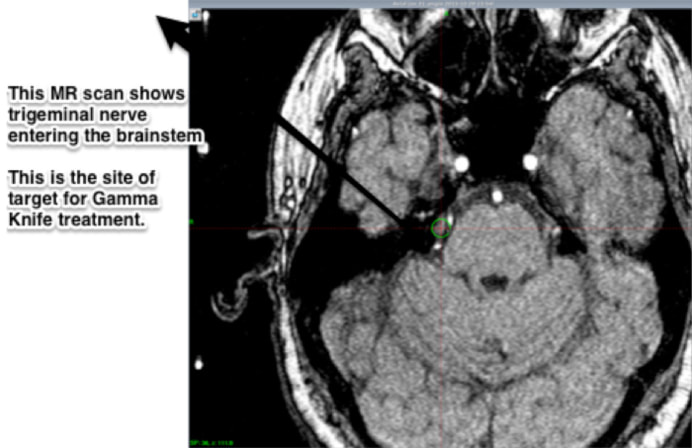Trigeminal Neuralgia
Trigeminal Neuralgia (tic douloureux, TN) is an extremely painful condition in which the patient has sudden shocks of pain in the face or forehead. Often chewing, brushing teeth, or wind blowing over the face triggers the pain. Trigeminal neuralgia may be caused by a blood vessel compressing the nerve; it may also be caused by multiple sclerosis or a tumor compressing the nerve.
Some authorities recognize two forms of the condition: In TN1, there is the classic, severe electric shock type of pain, while in TN2, the pain is described as aching, burning and long lasting than TN1. The results of all treatments (medications, surgery, gamma knife) for TN2 are not as good as for TN1.

Often medications (antiseizure medications or antidepressants) may be initially helpful, but in patients in whom the medications lose effectiveness or in whom side effects of the medication become troublesome, surgical treatments are sought. Surgery includes:
- Microvascular decompression (MVD)—this is the most invasive surgery in that it involves opening into the skull and separation of the compressing blood vessel from the nerve. The procedure has the advantage of offering the lowest recurrence rate—after 15 years, about half the patients may have recurrence of the pain. However, because it is an open surgical operation, the risks including anesthesia, brain retraction, and injury to nerves or brain stem are higher than for other procedures. In elderly patients, or patients with other medical conditions, this surgery would not be recommended. The surgery is not helpful for trigeminal neuralgia due to multiple sclerosis.
- Various percutaneous procedures have been developed in which a needle is placed through the cheek into the opening at the base of the skull where the nerve resides. Then, the nerve is compressed with a balloon, injected with glycerol, or ablated with heat (radiofrequency). In these procedures, there is brief anesthesia during the nerve lesioning. The procedure has fewer risks than MVD, but has a higher recurrence rate in that after 4 years, about half the patients have a recurrence of pain.
- Gamma knife radiosurgery is another commonly used method to treat trigeminal neuralgia in patients that medications have lost effectiveness. In this procedure, a single outpatient treatment under local anesthesia is done. The Gamma Knife unit directs a highly focused beam of radiation to the nerve just as it comes out of the brain stem. Dr. Young was one of the pioneers in using the Gamma Knife for Trigeminal Neuralgia. The effectiveness rate is about 80%, and it takes several weeks after the treatment for the effect to be seen. In patients in whom the pain recurs (about half the patients after 4 years), the procedure can be repeated.
Gamma knife treatment for trigeminal neuralgia is ideal for patients who do not want the risks of open surgery, and who understand the pros and cons of all the treatments currently available.
Trigeminal neuralgia related to multiple sclerosis can also be treated with Gamma Knife, but success rate in these patients is somewhat lower.
Results of Gamma Knife Treatment for Trigeminal Neuralgia
- Pain relief is not immediate—takes several weeks to months to occur.
- Many patients have had previous treatments (microvascular decompression, glycerol or radiofrequency treatment) and now have recurrence. Gamma knife treatment may be used for these patients.
- 80% of patients have initial pain relief, over time pain may recur. After 3 to 4 years, about half of patients may have recurrence.
- If pain does recur, treatment can be repeated.
- Incidence of facial numbness depends on details of treatment (dose and target) but with the dose and targeting we use, the incidence is 5%.
- Least invasive of any treatments.